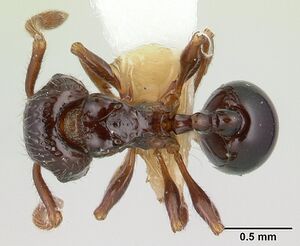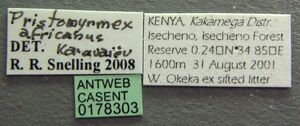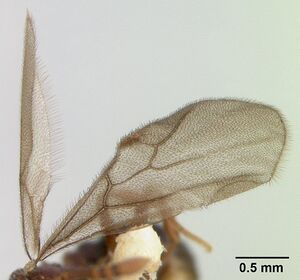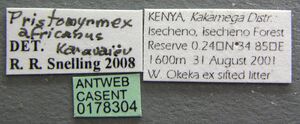Pristomyrmex africanus
| Pristomyrmex africanus | |
|---|---|

| |
| Scientific classification | |
| Kingdom: | Animalia |
| Phylum: | Arthropoda |
| Class: | Insecta |
| Order: | Hymenoptera |
| Family: | Formicidae |
| Subfamily: | Myrmicinae |
| Tribe: | Crematogastrini |
| Genus: | Pristomyrmex |
| Species: | P. africanus |
| Binomial name | |
| Pristomyrmex africanus Karavaiev, 1931 | |
| Synonyms | |
| |
Weber (1941:192; 1952: 18-20) noted that "workers were in rainforest of a luxuriant type referred to as gallery forest"; they were among the leaf and humus cover on the forest floor and were slow moving in habit; "when disturbed they became motionless,'feigning death' momentarily".
Identification
Wang (2003) - Masticatory margin of mandible with a long diastema after the preapical tooth; ventral surface of clypeus with two toothlike prominences; eyes containing four to five ommatidia in the longest row; dorsal surfaces of head between the frontal carinae and alitrunk with scattered foveolate punctures; petiole and postpetiole without hairs.
The workers of P. africanus can be separated from those of the other four African Pristomyrmex species as follows: (1) P. africanus possesses numerous foveolate punctures on the dorsal head between the frontal carinae that are not seen in Pristomyrmex trogor and Pristomyrmex orbiceps; (2) P. africanus has eyes containing four to five ommatidia in the longest row, as compared with eight or more usually present in P. orbiceps, Pristomyrmex fossulatus, and Pristomyrmex cribrarius; (3) P. africanus has two teeth on the ventral clypeus that are absent in P. orbiceps and P. fossulatus; (4) P. africanus lacks coarse longitudinal rugae and erect or suberect hairs on the petiole and the postpetiole that are present in P. cribrarius.
Bolton (1981) - P. africanus separates easily from Pristomyrmex cribrarius as the latter is densely hairy, strongly sculptured, has a palp formula of 4,3 (as opposed to 1,3 in africanus), and has much larger eyes. Pristomyrmex trogor differs from africanus as the former lacks frontal carinae and has longer scapes, a less densely hairy alitrunk and lacks foveolate punctures on the dorsum of the head. The foveolate cephalic sculpture seen in africanus is, however, also present in Pristomyrmex fossulatus, but in this species the eyes are much larger (0.26-0.29 x HW) and the pronotum has only a pair of blunt tubercles, not sharp teeth such as are seen in africanus.
A member of the Quadridens species group
Keys including this Species
Distribution
Latitudinal Distribution Pattern
Latitudinal Range: 3.783333333° to -9.39°.
| North Temperate |
North Subtropical |
Tropical | South Subtropical |
South Temperate |
- Source: AntMaps
Distribution based on Regional Taxon Lists
Afrotropical Region: Angola, Cameroun, Central African Republic, Democratic Republic of Congo, Gabon, Ghana, Kenya (type locality), Sudan, Uganda, United Republic of Tanzania.
Distribution based on AntMaps
Distribution based on AntWeb specimens
Check data from AntWeb
Countries Occupied
| Number of countries occupied by this species based on AntWiki Regional Taxon Lists. In general, fewer countries occupied indicates a narrower range, while more countries indicates a more widespread species. |

|
Estimated Abundance
| Relative abundance based on number of AntMaps records per species (this species within the purple bar). Fewer records (to the left) indicates a less abundant/encountered species while more records (to the right) indicates more abundant/encountered species. |

|
Biology
|
Castes
Worker
Images from AntWeb
   
| |
| Worker. Specimen code casent0178303. Photographer Erin Prado, uploaded by California Academy of Sciences. | Owned by LACM, Los Angeles, CA, USA. |
Queen
Images from AntWeb
    
| |
| Queen (alate/dealate). Specimen code casent0178304. Photographer Erin Prado, uploaded by California Academy of Sciences. | Owned by LACM, Los Angeles, CA, USA. |
Nomenclature
The following information is derived from Barry Bolton's Online Catalogue of the Ants of the World.
- africanus. Pristomyrmex africanus Karavaiev, 1931d: 47, fig. 5 (w.) KENYA. Wang, M. 2003: 424 (q. and ergatoid q.). Combination in Hylidris: Weber, 1952: 17; in Pristomyrmex: Bolton, 1981b: 284. Senior synonym of beni, mbomu, myersi, primus: Bolton, 1981b: 284.
- myersi. Hylidris myersi Weber, 1941a: 190, figs. 8, 9 (w.) SUDAN. Weber, 1952: 18 (q.). Junior synonym of africanus: Bolton, 1981b: 284.
- beni. Hylidris myersi subsp. beni Weber, 1952: 20 (w.) DEMOCRATIC REPUBLIC OF CONGO. Junior synonym of africanus: Bolton, 1981b: 284.
- mbomu. Hylidris myersi subsp. mbomu Weber, 1952: 19 (w.) CENTRAL AFRICAN REPUBLIC. Junior synonym of africanus: Bolton, 1981b: 284.
- primus. Hylidris myersi subsp. primus Weber, 1952: 19 (w.) DEMOCRATIC REPUBLIC OF CONGO. Junior synonym of africanus: Bolton, 1981b: 284.
Unless otherwise noted the text for the remainder of this section is reported from the publication that includes the original description.
Description
Worker
Wang (2003) - TL 2.76-3.40, HL 0.74-0.90, HW 0.74-0.93, CI 98-104, SL 0.68-0.83, SI 86-95, EL 0.08-0.12, PW 0.48-0.58, AL 0.68-0.85, PPW 0.22-0.27, PPL 0.18-0.22, PPI 110-13.5 (n = 27).
Mandibles with a few longitudinal basal algae. Masticatory margin of mandible with an apical tooth + a preapical tooth + a long diastema + a broad and truncated (or somewhat midconcave) basal tooth. Basal margin of mandible almost straight lacking a toothlike prominence or curved lobe. Clypeus possessing or lacking a median longitudinal carina. Anterior clypeal margin with a median denticle and two others on each side, but two lateral denticles are usually fused into one prominence. Ventral surface of clypeus with two toothlike prominences. Palp formula 1,3. Frontal carinae extending to the level of the posterior margins of eyes. Antennal scrobes indistinct or very weak. Frontal lobes absent; thus, the antennal articulations are entirely exposed. Antennal scapes, when lying on the dorsal head, close to, or slightly surpassing, the occipital margin of head. Eyes containing four to five ommatidia in the longest row. Promesonotum, in dorsal view, sometimes slightly concave. Pronotum usually with a pair of teeth or short spines but rarely with a pair of tubercles. Propodeum with a pair of teeth or short spines. Metapleural lobes rounded. Petiole node high in profile, higher than long, with a long anterior peduncle; its anterodorsal angle distinctly higher than the posterodorsal one that is usually rounded. Subpetiole with a narrow flange. Postpetiole in profile higher than long, rounded dorsally, in dorsal view broadening from front to back and broader than long. Dorsum of head between the frontal carinae and the sides of head, with numerous scattered foveolate punctures; sometimes the punctures are shallow and sparse. Dorsum of alitrunk smooth, except for a few foveolate punctures shallow or conspicuous, present on each side of the mesonotum. Petiole, postpetiole, and gaster smooth and shining. Dorsum of head between the frontal carinae, with some erect or suberect hairs. Promesonotum with a few pairs of hairs. Propodeum, dorsal surfaces of petiole and postpetiole, and first gaster tergite lacking erect or suberect hairs. A few pairs of forward-projecting hairs present on the anterior clypeal margin. Scapes and tibiae with decumbent hairs. Color reddish-brown, but gaster darker.
Bolton (1981) - TL 2.7-3.4, HL 0.70-0.90, HW 0.68-0.92, CI 97-104, SL 0.62-0.86, SI 85-94, PW 0.46-0.60, AL 0.68-0.92 (20 measured).
Base of mandible with 1-2 fairly strong rugulae present; frequently these fade out distally but in a few they may extend to the apical margin. Apical (masticatory) margin with a strong apical and preapical tooth followed by a diastema and a broad basal tooth formed by the fusion of two basal denticles. Frequently this broad basal tooth shows two points but these are often worn down and only a single blunt prominence remains. Clypeus usually with a median longitudinal carina but this is variously reduced or lost in different samples. Anterior cJypeal margin with a median denticle and 1-2 pairs on each side of it, sometimes the lateral pairs not strongly developed. Frontal carinae present, running back to or beyond the level of the posterior margins of the eyes and strongly divergent in their anterior halves. Strongly developed scrobes absent but sides of head between frontal carinae and eyes slightly concave and forming an unsculptured scrobal area. Maximum diameter of eye 0.09-0.12, about 0.12-0.15 x HW and with 4-5 ommatidia in the longest row. With the head in full-face view the occipital margin broadly and shallowly concave to conspicuously indented medially, the sides convex. With the alitrunk in profile the pronotum armed with a pair of acute triangular teeth or short spines; propodeum armed with a pair of spines which are somewhat variable in length and thickness. Metapleural lobes prominent and rounded. Petiole and postpetiole in profile rounded, without acute angles. Shape of petiole node variable. Dorsum of head between frontal carinae to occipital margin with foveolate punctures present at least from level of eyes backwards. Both intensity of development and number of punctures very variable; at one extreme the punctures are dense, sharply incised and conspicuous whilst at the other extreme the punctures are sparse, shallow and feebly incised. Sides of head in front of, below, and behind eyes also with foveolate punctures, and punctures usually also present at the posterior end of the scrobal area. Alitrunk unsculptured or at most the dorsum with a few feeble rugular traces on the pronotum. Petiole, postpetiole and gaster unsculptured. Mouthparts, ventral surface and dorsum of head with dense fine pilosity, on the dorsum the hairs arising along the line of the frontal carinae longer than those arising between the carinae. Pronotal dorsum with a transverse row of 3-4 pairs of hairs anteriorly; mesonotum with 3-4 pairs of hairs arising on the lateral margins; propodeum hairless. Petiole, post petiole and first gastral tergite without hairs but hairs present on apex of gaster. Scapes and tibiae with pubescence, more conspicuous on the former than on the latter. Colour varying from orange-brown to blackish brown, frequently with the gaster darker in shade than the alitrunk and head.
Queen
Wang (2003) - Ergatoid TL 3.70, HL 0.94, HW 1.00, CI 106, SL 0.85, SI 85, EL 0.16, PW 0.60, AL 0.92, PPVV 0.30, PPL 0.20, PPI 150 (n = 1).
Similar to worker; color and pilosity as in worker. Sculpture, except for mesonotum where a few rugae present, as in worker. The head with three ocelli; eyes larger, with six to seven ommatidia in the longest row; pronotum armed with a pair of acute minute spines; propodeum with a pair of short spines; mesonotum more convex, and metanotal groove present. Flight sclerites and wings lacking, but a black speck is present on the each lateral margin of mesonotum.
Queen TL 3.40-3.82, HL 0.84-0.96, HW 0.86-1.02, CI 102-107, SL 0.74-0.88, SI 82-89, EL 0.20-0.21, PW 0.70-0.74, AL 0.90-1.04, PPW 0.28-0.30, PPL 0.20-0.22, PPI 132-143 (n = 5).
General shape with normal caste differences from the conspecific worker. Eyes larger. Pronotum lacking teeth or spines but sometimes with a pair of blunt tubercles. Mesonotum with more hairs than in worker. Other characters similar to worker.
Type Material
Bolton (1981):
Holotype worker, Kenya: Mabira, no. 5322 (Dogiel & Sokolov) (ZM, Kiev) [examined].
Hylidris myersi Syntype workers, Sudan: Equatoria, Aloma Plateau, Khor Aba, 3700 ft [1290 m], 10.viii.1939, no. 1470, 1474 (N. A. Weber) (The Natural History Museum, Museum of Comparative Zoology) [examined].
Hylidris myersi subsp. mbomu Holotype worker, Central African Republic: Ubangi-Shari, Bas Mbomu, 5 miles [8 km] W. of Bangassau, 12.iii.1948, no. 2210 (N. A. Weber) (American Museum of Natural History) [examined].
Hylidris myersi subsp. primus Holotype worker, Zaire: Stanley ville [Kisangani], 19.iii.1948, no. 2235 (N. A. Weber) (AMNH) [examined] Hylidris myersi subsp. beni Syntype workers, Zaire: 15 miles [24 km] N. of Beni, 25.ii.1948, no. 2129 (N. A. Weber) (AMNH, MCZ) [examined].
References
- Bolton, B. 1981b. A revision of six minor genera of Myrmicinae (Hymenoptera: Formicidae) in the Ethiopian zoogeographical region. Bull. Br. Mus. (Nat. Hist.) Entomol. 43: 245-307 (page 284, Combination in Pristomyrmex, Senior synonym of beni, mbomu, myersi and primus)
- Karavaiev, V. 1931d. Ameisen aus Englisch-Ostafrika. Zool. Anz. 95: 42-51 (page 47, fig. 5 worker described)
- Radchenko, A.G., Fisher, B.L., Esteves, F.A., Martynova, E.V., Bazhenova, T.N., Lasarenko, S.N. 2023. Ant type specimens (Hymenoptera, Formicidae) in the collection of Volodymyr Opanasovych Karawajew. Communication 1. Dorylinae, Poneromorpha and Pseudomyrmecinae. Zootaxa, 5244(1), 1–32 (doi:10.11646/zootaxa.5244.1.1).
- Wang, M. 2003. A Monographic Revision of the Ant Genus Pristomyrmex (Hymenoptera:Formicidae). Bulletin of the Museum of Comparative Zoology 157(6): 383-542 (page 423, figs. 105-108 queen described)
- Weber, N. A. 1941a. Four new genera of Ethiopian and Neotropical Formicidae. Ann. Entomol. Soc. Am. 34: 183-194.
- Weber, N. A. 1952a. Studies on African Myrmicinae, I (Hymenoptera, Formicidae). American Museum Novitates 1548: 1-32 (page 17, Combination in Hylidris)
References based on Global Ant Biodiversity Informatics
- Belshaw R., and B. Bolton. 1994. A survey of the leaf litter ant fauna in Ghana, West Africa (Hymenoptera: Formicidae). Journal of Hymenoptera Research 3: 5-16.
- Belshaw R., and B. Bolton. 1994. A survey of the leaf litter ant fauna in Ghana, West Africa (Hymenoptera: Formicidae). Journal of Hymenoptera Research. 3: 5-16.
- Bolton B. 1981. A revision of six minor genera of Myrmicinae (Hymenoptera: Formicidae) in the Ethiopian zoogeographical region. Bulletin of the British Museum (Natural History). Entomology 43: 245-307.
- Fisher B. L. 2004. Diversity patterns of ants (Hymenoptera: Formicidae) along an elevational gradient on Monts Doudou in southwestern Gabon. Memoirs of the California Academy of Sciences 28: 269-286.
- Garcia F.H., Wiesel E. and Fischer G. 2013.The Ants of Kenya (Hymenoptera: Formicidae)Faunal Overview, First Species Checklist, Bibliography, Accounts for All Genera, and Discussion on Taxonomy and Zoogeography. Journal of East African Natural History, 101(2): 127-222
- Karavaiev V. 1931. Ameisen aus Englisch-Ostafrika. Zool. Anz. 95: 42-51.
- Laciny A., H. Zettel, A. Pal, and D. Zimmermann. 2016. The ant genus Pristomyrmex (Insecta: Hymenoptera: Formicidae) in the collection of the Natural History Museum Vienna. Ann. Naturhist. Mus. Wien B 118: 61-72.
- Ross S. R. P. J., F. Hita Garcia, G. Fischer, and M. K. Peters. 2018. Selective logging intensity in an East African rain forest predicts reductions in ant diversity. Biotropica 1-11.
- Wang M. 2003. A Monographic Revision of the Ant Genus Pristomyrmex (Hymenoptera:Formicidae). Bulletin of the Museum of Comparative Zoology 157(6): 383-542.
- Wang M. 2003. A monographic revision of the ant genus Pristomyrmex (Hymenoptera:Formicidae). Bulletin of the Museum of Comparative Zoology 157(6):383-542
- Weber N. A. 1941. Four new genera of Ethiopian and Neotropical Formicidae. Ann. Entomol. Soc. Am. 34: 183-194.
- Weber N. A. 1943. The ants of the Imatong Mountains, Anglo-Egyptian Sudan. Bulletin of the Museum of Comparative Zoology 93: 263-389.
- Weber N. A. 1952. Studies on African Myrmicinae, I (Hymenoptera, Formicidae). American Museum Novitates 1548: 1-32.

